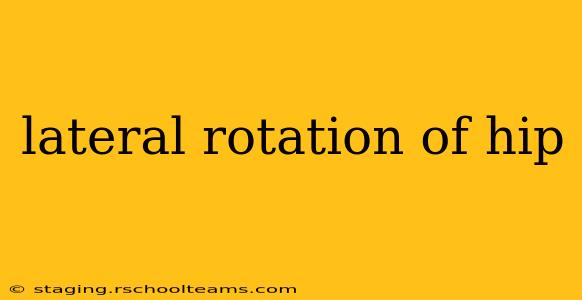Lateral rotation of the hip, also known as external rotation, is a fundamental movement that plays a crucial role in daily activities and athletic performance. Understanding its mechanics, benefits, and how to improve it safely is key to maintaining healthy hips and optimizing movement. This comprehensive guide explores the intricacies of hip lateral rotation, providing insights for both fitness enthusiasts and healthcare professionals.
Understanding Hip Lateral Rotation
The hip joint, a ball-and-socket articulation between the femur (thigh bone) and the acetabulum (hip socket), allows for a wide range of motion. Lateral rotation refers to the outward movement of the thigh bone away from the midline of the body. This rotation occurs in the transverse plane and involves several key muscles.
Muscles Involved in Lateral Hip Rotation
Several muscle groups contribute to hip lateral rotation, each with its own specific role:
-
Deep External Rotators: These six muscles, located deep within the hip, are crucial for stabilizing the hip joint and initiating lateral rotation. They include the piriformis, obturator internus, obturator externus, gemellus superior, gemellus inferior, and quadratus femoris. These muscles are often overlooked but are vital for proper hip function.
-
Gluteus Maximus: While primarily responsible for hip extension, the gluteus maximus also contributes significantly to lateral rotation, especially during powerful movements.
-
Tensor Fasciae Latae (TFL) and Iliotibial (IT) Band: These structures, while not direct rotators, influence hip mechanics and can contribute to lateral rotation indirectly. Tightness in the IT band can restrict hip rotation.
Benefits of Improving Hip Lateral Rotation
Adequate hip lateral rotation is essential for several reasons:
-
Reduced Risk of Injury: Improved hip mobility reduces stress on the joint, decreasing the risk of strains, sprains, and other injuries. This is especially important for athletes and individuals participating in high-impact activities.
-
Enhanced Athletic Performance: Optimal hip rotation is crucial for generating power and speed in movements like running, jumping, and kicking. Restricted rotation can significantly limit athletic performance.
-
Improved Posture and Balance: Proper hip rotation contributes to good posture and balance, helping to maintain proper alignment and stability. Poor hip rotation can contribute to imbalances and postural issues.
-
Pain Relief: Tightness or weakness in the hip rotator muscles can lead to pain in the hip, groin, and lower back. Improving hip rotation can alleviate pain and discomfort.
-
Increased Range of Motion: Increased lateral rotation improves overall hip mobility, allowing for greater freedom of movement in daily activities and physical activities.
Exercises to Improve Lateral Hip Rotation
Several exercises can effectively improve hip lateral rotation, targeting the muscles involved and enhancing mobility:
1. External Rotation with Resistance Band:
This exercise effectively strengthens the deep external rotators. Loop a resistance band around your ankles, keeping your knees slightly bent and feet shoulder-width apart. Slowly rotate your legs outwards against the resistance, maintaining control throughout the movement.
2. Clamshells:
Lie on your side with knees bent at a 90-degree angle. Keep your feet together and slowly lift your top knee, maintaining contact between your feet. This exercise primarily targets the gluteus medius and minimus, indirectly assisting with lateral rotation.
3. Figure Four Stretch:
Lie on your back with knees bent. Cross your right ankle over your left thigh, just above the knee. Gently pull your left thigh towards your chest to deepen the stretch. This helps to release tension in the gluteus maximus and piriformis.
4. Pigeon Pose (Yoga):
This yoga pose targets the hip rotators and improves flexibility. Start on all fours, bring your right knee forward behind your right wrist, and extend your left leg back. Gently lower your hips towards the floor, feeling a stretch in your hip.
5. Hip Rotations:
Standing or sitting, perform slow, controlled rotations of your hip outwards and inwards. This simple exercise improves mobility and awareness of hip movement.
When to Seek Professional Help
If you experience persistent hip pain or limited range of motion, consult a physical therapist or healthcare professional. They can assess your individual needs, identify the underlying cause of the problem, and recommend appropriate treatment strategies, which may include manual therapy, targeted exercises, or other interventions. Ignoring hip problems can lead to more significant issues down the line. Proactive care is essential for maintaining healthy hips and optimizing movement throughout life.
